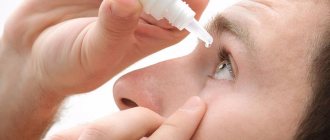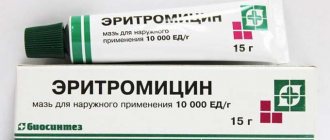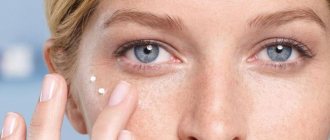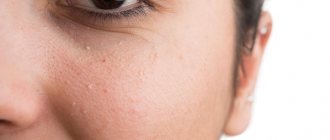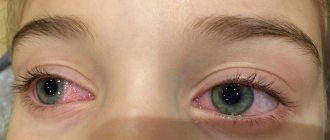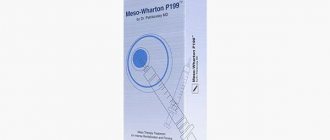General information
The term “ milium ” refers to whiteheads, which mainly appear due to overactive activity of the sebaceous glands.
The name comes from the Latin word for millet. Therefore, in everyday life this disease is also called millet. This cosmetic defect does not cause harm to health. Milia feel like small nodules to the touch. Most often, millet appears on the face; the most typical disease is for women and newborns. However, milia on the face or on another part of the body is not a pimple, but a benign formation. Apart from the white formations themselves, this phenomenon does not provoke any other symptoms. Therefore, treatment is carried out only if millet causes cosmetic discomfort.
How is diagnosis carried out?
A cosmetologist will help you get rid of problematic milia on your face, but first it is recommended to consult a dermatologist. The doctor will examine the affected area and make a diagnosis based on the clinical picture. Standard removal is carried out as follows: the doctor cleans the skin and makes an incision in the area of the stratum corneum of the tumor. The pus or solid core is then removed (depending on the type of milia). To exclude a malignant process, you need to send the material for histology. The study will reveal what contents are in the horny mass. Depending on the characteristics of the skin, the extracted core can be dense or loose.
Most popular: Natural and cosmetic antioxidants for youth
Millet requires differential diagnosis, during which it is distinguished from a retention cyst of the sebaceous gland. This disease develops in people suffering from seborrhea. Doctors have not developed preventive measures that could prevent the appearance of milia. To avoid acne and other skin defects, you need to eat right, eliminating spicy, salty, pickled, and peppered foods from your diet.
It is important to cleanse your pores in a timely manner. Cosmetics should be selected based on the needs of your skin. You should not buy products of questionable quality. Acne, in which ulcers form on the face, is often associated with stress and lack of sleep. Thus, conflict situations must be avoided. It is necessary to rest in a timely manner. Prevention of infectious and inflammatory diseases should be observed.
Pathogenesis
Another name for this manifestation is retention miliary cysts . In the process of chemical analysis of the contents of milia, it was determined that it contains keratin - dead cells mixed with fat. Their structure is dense, not similar to the contents of acne , since they contain relatively little sebum. These formations are small - their diameter is no more than 2 mm. The milia capsule is located separately from the sweat and fat ducts. The formations are localized mainly on the cheekbones, eyelids, temples, forehead, and near the lips. They rarely form on the chin. Milium has a cystic structure, and there are no passages outward, so it is difficult to squeeze out the formation.
Such acne forms due to specific processes. Apoptosis is the process by which damaged, overproduced and old cells in the body are eliminated. But sometimes apoptosis is disrupted, which leads to the development of a number of skin diseases, including the formation of milia.
The surface of the skin is renewed every 2-4 weeks. However, this process is correct and timely only when a sufficient level of cell apoptosis occurs in the skin and the intercellular substance is renewed in a timely manner. The intercellular substance consists of collagen and elastin . In the intercellular space, elastin and collagen fibers are removed by fibroblasts - special cells. But if their activity is insufficient, then the old fibers are not removed, but become denser and close the cell, preventing the entry of necessary substances into it and the removal of metabolic products. As a result, keratinocytes die, but they are not removed. Dead cells remain in the skin, surrounded by a sheath of connective tissue. As a result, milia appear. It is impossible to remove these formations using acne treatment products.
This type of formation also sometimes occurs in newborns. During the period of intrauterine development of the fetus, sebaceous glands are formed already in the third month. The impact of a number of factors on the body of the expectant mother leads to the development of milia in newborns. As a rule, after some time their number becomes smaller and they disappear on their own.
Milia removal
Removing milia should not be carried out independently by banal squeezing - this may not bring any result at all or provoke the formation of a scar at the site of aggressive influence. In addition, there is a high risk of penetration of an infectious agent into the resulting wound and further development of the inflammatory process with the formation of purulent contents.
Treatment can occur using the following methods:
- removal by a dermatologist using a sterile needle;
- laser therapy;
- electrocoagulation;
- radio wave therapy;
- deep and superficial facial cleansing (peelings);
- folk remedies – masks, scrubs.
Removing milia using a sterile needle
How to get rid of it on a child's face
Doctors do not recommend getting rid of milia on a child’s face through cosmetic procedures - often at a young age such a defect disappears on its own and without a trace.
What can and should be done:
- wash your face often with warm water;
- use only age-appropriate cosmetics for skin care (the best option is to consult a dermatologist or cosmetologist about the choice);
- For washing, you need to use cleansing gels or soft, gentle soap, without dyes or fragrances.
If millet has formed on the face of a teenager, then you can use lotion with retinol - they wipe the areas with characteristic formations once every 2 days . Be sure to first wash the skin, dry it with a towel and wait 20-30 minutes to completely dry the epidermis.
How to properly wash your face with warm water
To prevent the appearance of new formations, you need to avoid direct sunlight on your face.
Is it possible to remove milia yourself with a needle?
Doctors categorically do not recommend removing milia on your own with a needle - this requires compliance with antiseptic rules. But if there is no opportunity to seek qualified help, then you must first study the algorithm for this procedure:
- The needle is disinfected - boiled in water or wiped with medical alcohol.
- The site of the manipulation is wiped with any antiseptic solution - for example, Miramistin, Chlogexidine.
- The needle is inserted into the middle of the millet, the contents that appear outward are carefully squeezed out with your fingers, which are first wrapped in sterile napkins.
- After removing the contents of the milium, you need to wipe the treated area with an antiseptic solution.
This procedure can only be carried out in the evening, when you will not need to go outside for the next 2-4 hours. The recovery period after such mechanical removal of millet lasts 1-2 days. During this period, you need to touch the fireplace with your hands as little as possible, wash your face frequently and wipe it with Miramistin or Chlorhexidine.
Watch the video about how milia are removed:
Self-removal with a needle may not work, because some milia are located in the deep layers of the dermis.
How to get rid of it at home
You can get rid of milia at home; for this you will need vitamins, ointments, decoctions, infusions, scrubs. This will require several months of regular treatments. All traditional medicine products have a natural composition, and before you start using them, you must make sure that you are not allergic to all components.
What to smear
You can smear the skin with formed millet patches with some pharmaceutical products:
- vitamins A and E - sold in ampoules, added to your usual moisturizer in the proportion of 2 ml per teaspoon of base;
- Zinerit, Ugresol are products with pronounced antibacterial and antiseptic effects.
You need to treat the skin with the formations in question 2 times a day; first clean it. If the cream with vitamins is used in the morning, then you need to wait 20-30 minutes for it to be completely absorbed, after which the excess is removed with napkins.
The course of using the drugs is at least 1 month on a daily basis; doctors recommend not stopping until the desired result is obtained. But experts warn that milia may only disappear after 5-6 months, and this is not guaranteed.
Treatment with folk remedies
Treatment with folk remedies is the use of poultices, ice cubes, and washing. The most effective products will be those prepared from a decoction/infusion of chamomile or calendula flowers.
Recipes for preparing the base:
- for the decoction - take 1 tablespoon of plant material, add 200 ml of water and boil in a water bath for 5-10 minutes, cool and strain;
- for infusion - 2 tablespoons of chamomile or calendula flowers, pour 500 ml of boiling water and leave in a sealed container for 30-40 minutes.
Use the prepared products as follows:
- make lotions - moisten a gauze cloth in a warm decoction or infusion and apply it to the face, as it cools/dries, the gauze is moistened again in the product, the procedure lasts at least 30 minutes;
- treat the skin with milia with ice cubes from the indicated products - you can do this in the morning and evening;
- prepare a complex mask - add 2 tablespoons of oatmeal, 1 teaspoon of liquid honey and 5 drops of cosmetic or olive oil to 100 ml of decoction or infusion, apply to the face and wash off after 20 minutes.
Watch the video of the treatment of milia with folk remedies:
Procedures with folk remedies are performed daily and for several months. Before applying a lotion, wiping your face with ice and using a complex mask, you need to cleanse your skin of makeup, dirt and dust.
How to remove milia with masks and scrubs
You can remove milia with the help of masks; the most effective are:
- Potato mask . Prepared from 1 potato, boiled in their jackets. It is cooled to a warm state, kneaded with a fork without preliminary cleaning. To the resulting mass add 1 tablespoon of liquid honey and the same amount of sour cream (fat, homemade). The result should be an almost homogeneous mass, but there may be small lumps in it.
The finished mask is applied to the face in an even layer and remains there for 20-30 minutes. You can put a gauze pad soaked in hot water on top and “renew” it every 5 minutes. After the procedure, the face is washed with warm water and treated with any moisturizer.
- Cucumber mask . You need to “extract” juice from 1 vegetable - grate the cucumber or chop it in a blender and squeeze the mass through cheesecloth. Cottage cheese with a medium level of fat content is added to it (proportions 1:1), rub everything with a fork until a homogeneous mass is obtained. It is applied to the skin with prosyanki and remains there for 15 minutes, after which it is washed off with cool water.
This mask also has an additional effect - it whitens age spots, improves skin tone, and well moisturizes all layers of the dermis. To prepare it, you need to take only “natural” cucumbers - grown in garden beds and in season.
- Paraffin . Medical paraffin is taken, melted in a water bath and applied in a thin layer to the face with a silicone brush. As soon as the first layer has dried, the next one is applied, this manipulation is repeated 4 times. The total time the mask remains on the skin is 20 minutes from the moment the last layer is applied. The paraffin is removed with a smooth movement from the chin up to the forehead. Immediately after this, the skin is lubricated with moisturizer.
Paraffin can be very hot after being in a water bath; you need to monitor its temperature to prevent burns.
- Viburnum juice mask . You need to get juice from viburnum berries, then add wheat or oatmeal to it in such a volume that the “output” is a creamy mass that is resistant to dripping. It is applied to previously cleansed facial skin and left for 20 minutes. You can simply wipe your face with viburnum juice by soaking a cotton pad in the product. This is done 2-3 times a day; you need to wash your face before the procedure.
Scrubs at home are a superficial peeling that cleanses the epidermis of all formations and keratinized scales. The easiest way to use it is to mix a small amount of baking soda with liquid soap (the mass should be thick, with undissolved particles of the dry product).
You should wash your face with it - carefully spread it over your face with your fingers, whip up foam, massage, the procedure lasts 3-5 minutes. Immediately after finishing you need to wash with warm water.
Watch the video about the recipe for making a soda facial scrub:
A scrub made from soda is great for caring for sensitive, delicate skin.
If the dermis is of normal or combination type, then you can use a scrub made from table salt:
- Mix 1 teaspoon of salt with crushed oat flakes (grits);
- add a small amount of vegetable oil (sunflower, olive, corn) to the dry mass;
- apply the mixture to the face, work the skin with soft massage movements;
- Leave the scrub on your face for another 10 minutes and rinse with cool water.
Scrubbing is performed once a week for sensitive skin and 2 times for normal skin. Course duration is at least 1 month. After the first procedures, side effects such as severe redness of the dermis and slight peeling may occur.
Remedy for milia from tomatoes
It is considered an effective remedy for milia from tomatoes - it acts like a light acid peeling and can be used even on sensitive skin. You just need to remove the peel from the tomato, mash the pulp with a fork and apply it to problem areas for 20-30 minutes.
This vegetable contains a large amount of vitamin C, so experts recommend adding a small amount of vegetable oil (preferably olive) to the tomato mass - ½ teaspoon for 1 medium tomato.
The tomato mask can be used 2 times a day. If you have a history of allergy to this product, the product is contraindicated. After washing off the tomato mass, you need to wash your face with warm water and apply moisturizer to your skin.
Treatment in adults with salicylic acid
In adults, treatment with salicylic acid can be carried out, but not in its pure form, but as part of pharmaceutical ointments, and the simplest remedy is Salicylic ointment, which is applied pointwise to milia. Application regimen: 1 time every two days during the first week, 1 time daily in the 2nd week and twice a day for another 2 weeks. Salicylic ointment is quite aggressive, so you should avoid getting it on healthy skin.
Even with such careful use, side effects may occur:
- redness;
- peeling;
- slight itching.
Usually they disappear on their own after 3-4 applications, but if they continue to be present or gain intensity, then this is a reason to stop manipulation and seek help from a dermatologist - most likely, the allergy is progressing.
During the treatment of millet with salicylic ointment, you cannot use any other cosmetic or medicinal products for the skin; you can only wash with warm water and without using soap.
To enhance the effect and obtain faster results, cosmetologists recommend combining salicylic and zinc ointments in equal proportions and treating milia with the ready-made mixture. This is done once a day without breaks for a week, then the procedure is carried out in the mode of maintaining the result - 2-3 times a week.
Laser removal of grass
Laser removal of millet lesions is the most effective cosmetic procedure, during which the formations are removed layer by layer. This method has the following advantages:
- it is carried out painlessly for the patient; if the skin is overly sensitive, the doctor applies a cream/gel with an anesthetic effect;
- there is no risk of infection or bleeding - the laser beam has a bactericidal effect and immediately “glues” blood vessels together;
- After manipulation, scars are extremely rarely formed.
Contraindications to laser therapy:
- problems in the blood clotting system;
- fragility of blood vessels;
- rosacea;
- malignant tumors localized in any organ or system;
- neurological diseases, including epilepsy in the stage of long-term drug remission.
The photo shows the result before and after laser removal of milia.
The recovery period after laser treatment of milia is minimal - already on the 3rd day there is no redness or slight swelling on the skin. For a month you cannot visit baths, saunas and public swimming pools, or carry out deep cleaning procedures (peelings). The laser can remove both single milia and large clusters of them. In the latter case, repeated manipulations may be necessary.
Electrocoagulation of milia
Electrocoagulation of milia allows you to remove formations with alternating or direct current, which ensures the destruction of the capsular cyst. The manipulation is performed pointwise, this reduces the likelihood of injury to surrounding tissues to zero.
After the procedure, a crust (scab) is formed at the site of exposure, which is strictly forbidden to be removed or softened by any means - this can lead to the introduction of an infectious agent into the wound and the rapid development of an inflammatory process with suppuration.
The crust disappears on its own after 10 days - this is how long the recovery period lasts, during which you need to avoid direct sunlight on the skin, do not visit baths, saunas and solariums, do not use caring cosmetics and do not apply makeup.
The main advantage of electrocoagulation in the treatment of millet grass is the affordable price of the procedure. But there is a risk of scars forming in places exposed to electric current.
Classification
Milia are divided into two types:
- Primary - they develop spontaneously, they can be a consequence of the influence of ultraviolet radiation, etc. This type develops in newborns. As soon as the processes of separation of keratinized skin particles return to normal, this manifestation disappears. In adults, the primary form can be a consequence of hormonal imbalance, hyperkeratosis , poor hygiene, abuse of cosmetics, etc.
- Secondary - are a consequence of inflammation or trauma to the skin, developing in scars after wounds or burns. Unlike primary ones, they do not disappear on their own and can remain in scars throughout life.
Causes of blemishes on the face
The main reasons why so-called whiteheads develop under the skin on the face are associated with excessive production of keratin by cells. This phenomenon can be caused by the following factors:
- hormonal imbalance;
- hyperkeratosis;
- incorrect metabolic processes;
- thyroid dysfunction;
- digestive diseases;
- prolonged exposure to direct sunlight;
- incorrect approach to nutrition - consumption of large amounts of fatty and fried foods;
- of vitamins important for the body ;
- diseases of the adrenal glands and pancreas.
Due to hormonal imbalance, millet often appears not only in adults, but also in infants. When a baby is born, his body experiences a significant hormonal crisis, which leads to problems with the skin.
Another peak in the appearance of milia occurs during adolescence. During this period, very often keratinized cells are separated incorrectly, the regulation of sebum production is disrupted, and as a result, millet appears on the skin in parallel with acne. In adolescents, this is associated with the following phenomena:
- oily seborrhea , when there is hyperfunction of the sebaceous glands;
- increased levels of sex hormones;
- dysfunction of the autonomic nervous system;
- deficiency of vitamins and minerals;
- improper skin care, insufficient hygiene;
- hyperkeratosis of the hair follicle;
- abuse of junk food - soda, fast food, sweets;
- use of low quality cosmetics;
- dry skin due to improperly performed cosmetic procedures;
- side effects when using medications;
- inflammation of the skin, benign formations;
- ultraviolet action;
- bad habits.
The appearance of such formations may be associated with diseases, the course of which negatively affects the condition of the skin:
- bullous pemphigoid;
- porphyria cutanea tarda ;
- dystrophic epidermolysis bullosa ;
- lupus;
- sarcoidosis;
- gastrointestinal diseases;
- endocrine disorders.
No. 3 Medicines
Medicines may be required in cases where the problem lies in hormonal imbalance or diseases of the digestive tract. Patients are prescribed enterosorbents - activated carbon, white carbon, Smecta.
Vitamin complexes are useful , especially those with a high content of B vitamins and yeast. You can take immunostimulants. Hormonal drugs are prescribed only by a doctor and only after a full medical examination.
Be sure to read:
Causes of rosacea on the face (rosacea) and methods of treatment
Dietary supplement Inneov Clear skin
As for topical products for milia, the following can be used: zinc, sulfur and tar ointments, Erythromycin also in the form of an ointment (has an antibacterial effect), boric acid (or salicylic acid) is suitable for wiping and disinfecting the skin.
Find out how to properly apply sulfur-tar ointment.
These drugs eliminate pathogens, promote healing, regulate the body's hormonal balance and the functioning of the digestive tract, and also stimulate the defenses.
Symptoms
Most often, such formations appear on the face. Often, millet forms on the eyelid, and milia develop under the eyes. While milia on the eyelids are a fairly common occurrence, they appear less frequently on the limbs, abdomen, and genitals. These formations can appear at any age. Millet does not cause pain, discomfort or any unpleasant sensations.
The millet looks like a papule no larger than 2 mm in size. These white pimples can appear singly, but most often they form in groups. In appearance, these are small, round, dense nodules that have a yellow-white tint. The head of the pimple is not inflamed, but if microorganisms get inside, the formations can become inflamed and become purulent.
Sometimes, after a person has managed to get rid of such a manifestation, milia appear again.
What to do during treatment is not recommended
First of all, you should not self-medicate; it is important to consult a specialist and undergo a full medical examination. All recommendations and requirements of the doctor should be followed. Before using folk remedies, you should also consult a professional.
Be sure to read:
How to quickly remove swelling from a pimple and relieve swelling on the face in this place?
During treatment, you should not use decorative cosmetics, this will slow down the skin restoration process. It is important not to neglect personal hygiene; ignoring these procedures will only worsen the situation. You should also not sunbathe (either outdoors or in a solarium).
Is it possible to squeeze out
Is it possible to squeeze out pimples with a white head? Doctors categorically prohibit doing this. Squeezing will lead to nothing; the patient can only further infect the skin, which can only complicate the course of the pathology. Therefore, all manipulations of this kind are prohibited; it is better to immediately contact a specialist.
How to choose a good cream for acne on the face at the pharmacy? Useful recommendations from Kataliya.ru and a list of popular products. Find out how to take Polysorb for acne (adsorbent). In what cases can the drug help get rid of rashes?
Tests and diagnostics
A dermatologist diagnoses milia by examining the skin and identifying characteristic signs. The doctor interviews the patient, studies the medical history and collects anamnesis to determine the cause that triggered the development of millet.
Instrumental and laboratory studies, as a rule, are not practiced. If milia appear against the background of other diseases, the patient is advised to consult with specialists.
It is important to differentiate milia from fibrofolliculoma , trichodiscoma , fibroma , syringoma and xanthelasma .
Procedures and operations
The most common procedure for removing millet grass is the mechanical method. First, the skin is treated with an antiseptic. Then the specialist uses a sterile needle, opens the membrane, lifts the cyst and pushes it out. For this purpose, a special curette that resembles a spoon is also used. This tool makes it possible to completely scrape out the milia, and then the remnants of its contents will not turn into a cyst again after some time. In one procedure, a certain number of formations are removed – no more than 10.
Milia under the eyes are removed using radio waves , and diamond cleaning . A more aggressive method is burning ( laser removal, electrocoagulation ), which acts on the formations in a targeted manner.
Sometimes milia disappear on their own after a few months as the skin renews itself.
It is also important to ensure proper skin care and use products that will help normalize the oiliness of the epidermis.
No. 2 Removal using various procedures
White internal pimples can cause significant discomfort to the patient, so various methods for their removal are used.
Be sure to read:
What kind of clear liquid flows out when you squeeze a pimple?
Radio wave removal of milia is carried out using high frequency current pulses. Whiteheads are heated to such a temperature that they cannot exist and are destroyed. In this case, the tissue itself immediately undergoes a coagulation (healing) process.
This technique is bloodless and painless, provides a deep effect on the tissue, there are no scars left after the procedure and recovery is very fast, the risk of infection is reduced to zero. But this manipulation has contraindications: the patient has a pacemaker, heart disease, lung disease, liver disease and diabetes mellitus in the stage of decompensation, acute respiratory pathologies of the airways.
The cost of radio wave removal of white pimples ranges from 250 to 2000 Russian rubles. The final price depends on the amount of work done.
Laser removal of milia is widely used . The procedure is performed only in specialized conditions of a beauty salon. The essence of the manipulation is to polish the skin at several levels. A crust forms, which comes off and underneath there is clean skin.
We talk about 3 proven ways to use Vishnevsky ointment for acne.
Laser removal is also bloodless and practically painless, and has a disinfecting effect. The laser is able to reach even hard-to-reach affected areas (for example, if there are milia under the eyes or on the eyelid).
The cost of the procedure is on average 300 Russian rubles per session.
Another way is to remove milia on the face mechanically . The doctor thoroughly cleanses the skin, after which the pimple itself is pierced with a needle and its contents are removed using the syringe plunger. A fresh wound is also thoroughly disinfected.
This technique is quite traumatic, so it is carried out in several stages. This helps avoid infection of the skin and subcutaneous tissue.
The cost of the procedure is from 150 Russian rubles per session.
Treatment with folk remedies
You can use folk methods to combat millet grass. But most of them can produce an effect only with regular and long-term use. All traditional methods are based on mechanical cleansing of the skin from dead cells. When using products that act as peeling, you need to rub the skin very gently. Gradually, the milia coating will become thinner, and it will be possible to remove it yourself without damaging the skin.
- Soda and soap. First, you need to foam baby soap on your palm, then pour 1 tbsp onto the foam. l. soda Treat the skin with gentle movements and rinse off the composition. Use every other day for two weeks.
- Paraffin. Melt 70 g of paraffin in a water bath. Wipe your face with alcohol and apply several layers of paraffin to your face. The next layer can be applied when the previous one has hardened. Remove the mask when the paraffin has completely hardened.
- Pumpkin with sour cream. Finely grate the pumpkin pulp and mix it with sour cream to form a homogeneous mass. Apply the mask to your face and leave it for a quarter of an hour. The mask can be applied every day.
- Sea salt and olive oil. Mix these two components in equal proportions, take the mixture onto a cotton pad and lightly massage the affected areas. After this procedure, apply a moisturizer to your face.
- Viburnum with oatmeal. Grind the berries in a blender, add a little oatmeal and apply to the affected areas for 20 minutes. Rinse everything off with water.
- Yeast. 1 tbsp. l. mix yeast with 1 tbsp. l. lemon juice and the same amount of honey and hydrogen peroxide. Mix everything and apply to skin for 20 minutes. After this, rinse gently with water.
hydrogen peroxide at home to treat millet so as not to worsen the condition.
Treatment methods
Milia are treated surgically. Conservative methods do not help in this case. As we have already noted, formations are not squeezed out at home. It is necessary to contact an experienced specialist who will create suitable conditions. Salon procedures are safe, however, they are not without contraindications.
A couple of decades ago, curettage was popular, during which an incision was made and pus was removed through it. This treatment method is painful, and today it is used less and less. Electrocoagulation and laser therapy are used to remove tumors. The advantage of the procedures is the absence of visible scars. Curettage is significantly inferior in comparison. To carry out electrocoagulation or laser therapy, the doctor uses antiseptics. The products help cleanse the skin and prepare it for the treatment procedure. Depending on the problem, the doctor may prescribe a one-time or multiple-use procedure. If you remove many formations at once, you can damage the skin and disrupt the functioning of the sebaceous glands. A large number of milia require long-term treatment.
What is electrocoagulation?
Initially, the procedure was used in the gynecological field. The electrocoagulation method was used to perform operations during which pathological tissues were dissected. In medicine, this method is used to stop bleeding and cauterize affected areas. Using the electrocoagulation method, papillomas and condylomas located near the genitals are removed. The procedure is actively used in cosmetology. It is prescribed for condylomas, papillomas, and severe acne.
Electrocoagulation is a type of surgical intervention. The procedure is carried out as follows: the doctor treats the skin with an antiseptic. For removal, a constant or variable discharge is used. Thus, the milia is destroyed. Subsequently, a scab forms in its place: it consists of fragments of dead tissue. Electrocoagulation involves thermal, electrodynamic and physico-chemical effects.
The advantage of the procedure is that there is no risk of injury to nearby tissues. After electrocoagulation, cell regeneration accelerates. The technique involves the use of monopolar or bipolar electrodes. They differ in shape and size. For cosmetic purposes, needle-type electrodes are used (depending on the nature of the problem, the doctor may use a loop-shaped instrument).
After electrocoagulation, you need to follow the rules that will help speed up your recovery. It is important to ensure the prevention of suppuration. If you remove the formed crust yourself, a scar may remain! After electrocoagulation, the skin heals within 10 days. On the 6-7th day the scab comes off. Another advantage of electrocoagulation is its affordability. This treatment method is cheaper than laser removal.
Laser therapy in the fight against milia
Manipulation using an innovative device is recommended for severe acne, age spots, and large tumors. There are three types of laser. The use of one or the other depends on the characteristics of the skin and the depth of the tumor. Laser therapy is carried out by an experienced cosmetologist in a specialized office. The procedure must be agreed with a dermatologist. There are times when people come to a specialist after experiencing the negative consequences of self-removal of acne. Laser removal is also effective if cosmetics or folk remedies have not helped in the fight against the tumor.
Most popular: The best hand creams according to a cosmetologist
Laser treatment is recommended for large and small subcutaneous formations, and they can be located at a significant depth. The indication for the procedure is severe acne. Laser removal of milia is prescribed for multiple pustular rashes. The innovative technique also helps to cope with scars left after unsuccessful acne removal. The advantage of the procedure is that it is not traumatic and can be performed in combination with others. Laser facial cleansing has contraindications:
- it is not prescribed to patients with herpes virus infection;
- laser treatment is prohibited for endocrine diseases and diabetes;
- the procedure is not performed during pregnancy and lactation;
- contraindication is cancer;
- if there is damage in the area of the tumor, treatment is postponed until later.
- The procedure is not carried out at fever.
Types of laser
Neodymium. The device heats the cells of the sebaceous glands. The purpose of its influence is to normalize the functioning of these glands. The neodymium laser destroys fungi and bacteria living on the skin. It restores the flow of leukocytes and promotes rapid skin regeneration. Neodymium laser is used in a non-contact manner. It has no side effects.
- Erbium. This type of laser is used when acne progresses and if it reaches advanced stages. Erbium laser is often used to treat acne. During the procedure, facial resurfacing is performed. The device acts on the upper layers of the epidermis, stimulating the formation of healthy cells. The erbium laser destroys infection, smoothes the skin surface, and provides prevention of dermatological diseases.
- Alexandrite. This laser is used to treat milia, warts, and acne. The device can be used during hair removal. It has a powerful effect on the hair follicle.
When performing laser therapy, contraindications must be taken into account (they are the same as for the Electrocoagulation procedure). During a normal reaction of the body, the patient feels a tingling sensation at the site of exposure. The advantage of the procedure is that it does not require the use of painkillers. Laser pulses help overcome the inflammatory process.
Prevention
To prevent the formation of millet, the following prevention rules should be followed:
- Visit a doctor in a timely manner and identify pathologies of organs and systems. Monitor hormonal balance.
- Protect the skin from the aggressive effects of ultraviolet radiation. Use special protective equipment.
- Eat right, avoiding vitamin and mineral deficiencies and avoiding junk food. It is important to prevent a lack of zinc (it is found in protein products) and calcium (dairy products). You should not starve or adhere to too strict diets.
- Take proper care of your facial skin by selecting products with the help of professional cosmetologists. It is important to consider your skin type.
- Strictly monitor skin hygiene.
- Regularly carry out procedures aimed at properly exfoliating dead cells.
- As recommended by your doctor, take vitamin and mineral complexes.
Diet
Diet for acne
- Efficacy: therapeutic effect after 21-30 days
- Terms: 6-8 months
- Cost of products: 1700-1800 rubles. in Week
To prevent milia from occurring, you need to eat well, but not overeat or abuse junk food. In this case, it is advisable to adhere to the principles of the Acne Diet . The following products must be included in the menu:
- Lactic acid dishes - they will help improve the condition of the intestinal microflora.
- Liver, offal, seeds, nuts - they will help compensate for zinc deficiency.
- Fish of all varieties contains Omega-3 fatty acids , which have an anti-inflammatory effect.
- Vegetables, fruits, fresh herbs are sources of vitamins and antioxidants .
- Green tea is a powerful antioxidant.
Consequences and complications
If you deal with this cosmetic problem correctly, there will be no unpleasant consequences. But if there is an unprofessional approach to eliminating the pimples and incorrect actions at home, wounds, bruises, and later scars may remain in place of the pimples.
Infection in the resulting wound can lead to inflammation, abscess and other unpleasant diseases.
The risk of complications when removing milia in the eye area on your own is very high. When an infection occurs, an abscess of the eyelid may develop. There is also a risk of injuring the eyeball when using a needle.
Bacteria entering the eyelid area can lead to them subsequently ending up in the orbital veins, and later in the sinuses of the brain. As a result, sinus thrombosis may develop.
What are milia
Translated from Latin, “milium” means grain or simply. Due to this, the dermatological neoplasm has different names - millet, white pimples, retention miliary cysts, milia.
Milia come in 2 groups:
- primary - arise unexpectedly, often the cause of development is unfavorable external factors (excess ultraviolet rays);
- secondary - a consequence of traumatic events or inflammatory phenomena on the skin.
Milium is a small (2-3 mm in diameter) whitish neoplasm, similar in shape to the head of a pin. It can be compared to a small grain. They appear most often on the face - on the cheeks, on the lower or upper eyelids, chin and even on the nose. But their “favorite” place is the eyelids.
Neoplasms can be either single or numerous, representing white rashes. They do not cause pain or physical discomfort, their development occurs slowly.
Milium is not an inflammatory dermatological problem. This is a closed part of the skin in which keratinized epithelial cells with an admixture of subcutaneous fat have accumulated. If the head of the milia becomes red, this indicates the development of an inflammatory process, the cause of which is the introduction of pathogenic microorganisms into the skin pores.
The appearance of dermatological problems on the surface of the skin in many people (especially women) provokes the appearance of a complex. Often the neoplasms go away on their own within a few months, but they can also persist throughout life.
Milia treatments that are used to eliminate acne or pimples are ineffective. Milia are removed using completely different techniques. It is forbidden to squeeze out or break their integrity (by piercing or cutting), as this almost always causes infection in the subcutaneous layer, which is fraught with the development of serious complications.

